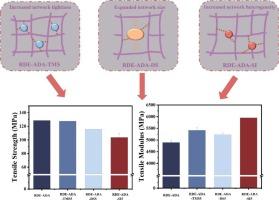Polar small molecule regulation of epoxy networks: Free volume filling, hydrogen bonding, and catalytic effects
IF 7.3
2区 材料科学
Q1 CHEMISTRY, APPLIED
引用次数: 0
Abstract
According to classical polymer physics, free volume is a critical factor influencing the mechanical behavior of epoxy-based coatings. In this study, three polar small molecules—Tetramethylene sulfone (TMS), Diphenyl sulfone (DS), and Succinimide (SI)—were incorporated into the epoxy network through molecular-level design to regulate the structure of network and enhance coating performance. By filling free volume and promoting hydrogen bonding, these additives improved both modulus and toughness of the coatings. The mechanisms underlying these effects were systematically elucidated using positron annihilation lifetime spectroscopy (PALS), molecular dynamics simulations, and DFT calculations. SI exhibited catalytic activity during the curing process, resulting in increased network heterogeneity, whereas TMS achieved an effective balance between strength and toughness, thereby improving impact resistance. The densified microstructure and strengthened intermolecular interactions imparted by polar small molecules endow the epoxy coatings with superior mechanical integrity under extreme mechanical environments. This work provides valuable insights into the structure–property relationship of epoxy coatings and offers a new strategy for designing high-performance protective coating systems.

环氧网络的极性小分子调控:自由体积填充、氢键和催化效应
根据经典聚合物物理学,自由体积是影响环氧基涂层力学性能的关键因素。本研究通过分子水平设计将四亚甲基砜(TMS)、二苯基砜(DS)和琥珀酰亚胺(SI)这三种极性小分子引入到环氧树脂网络中,以调节网络结构,提高涂层性能。通过填充自由体积和促进氢键,这些添加剂提高了涂层的模量和韧性。利用正电子湮灭寿命谱(PALS)、分子动力学模拟和DFT计算系统地阐明了这些效应的机制。SI在固化过程中表现出催化活性,导致网络异质性增加,而TMS在强度和韧性之间实现了有效的平衡,从而提高了抗冲击性。极性小分子赋予环氧涂层致密的微观结构和增强的分子间相互作用,使其在极端机械环境下具有优异的机械完整性。这项工作为环氧涂料的结构性能关系提供了有价值的见解,并为设计高性能防护涂料体系提供了新的策略。
本文章由计算机程序翻译,如有差异,请以英文原文为准。
求助全文
约1分钟内获得全文
求助全文
来源期刊

Progress in Organic Coatings
工程技术-材料科学:膜
CiteScore
11.40
自引率
15.20%
发文量
577
审稿时长
48 days
期刊介绍:
The aim of this international journal is to analyse and publicise the progress and current state of knowledge in the field of organic coatings and related materials. The Editors and the Editorial Board members will solicit both review and research papers from academic and industrial scientists who are actively engaged in research and development or, in the case of review papers, have extensive experience in the subject to be reviewed. Unsolicited manuscripts will be accepted if they meet the journal''s requirements. The journal publishes papers dealing with such subjects as:
• Chemical, physical and technological properties of organic coatings and related materials
• Problems and methods of preparation, manufacture and application of these materials
• Performance, testing and analysis.
 求助内容:
求助内容: 应助结果提醒方式:
应助结果提醒方式:


